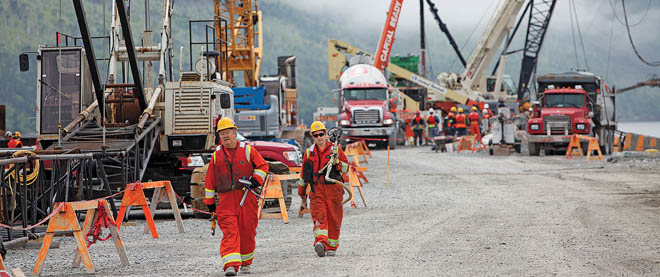Economic boom brings a labour shortage to Newfoundland
The archetypal “have not” province is bringing in foreign workers to help fill jobs
Vale Archive
Share

There may be no more surefire sign of an economic boom in Canada than a shortage of staff at the local Tim Hortons. It happened in northern Alberta when Fort McMurray exploded with oil sands-related activity. And now it’s happening in Deer Lake, in western Newfoundland. “We’re in the midst of a period of poor availability,” says local Tim Hortons’ owner Oral Clarke. He plans to bring in foreign workers from the Philippines to fill out his staff.
For a town of 5,000 that sits at a highway interchange near the entrance to Gros Morne National Park—never mind in a province with the highest unemployment rate in the country at 13.1 per cent—this may seem like a strange conundrum. But it’s indicative of a growing problem on the Rock. After decades of being Canada’s archetypal “have not” province, Newfoundland and Labrador is experiencing an unprecedented economic boom. And the record expansion brings an unfamiliar problem: an acute shortage of labour. “For years we’ve had people leaving the province because of too few jobs,” says Richard Alexander, executive director of the Newfoundland and Labrador Employers’ Council. “All of a sudden there’s been a switch and we’re entering an area where we have excess jobs and too few people to fill those jobs.”
More than $43 billion is pouring into major development projects across the province. Among the most prominent are the $8.3-billion Hebron offshore oil platform, the $3-billion Long Harbour nickel processing plant, and the $6.2-billion Muskrat Falls Lower Churchill hydroelectric project. The government surplus—once a rare figure on provincial balance sheets—climbed far beyond expectations to $755 million last year, thanks mostly to oil revenues, says Memorial University economist Wade Locke. In a report titled “ Outlook 2020,” the province estimated that 77,000 job vacancies will open up over the next eight years (with more projects announced since the report, that estimate is widely perceived to be conservative).
The government is warning that the labour shortage could even dampen economic growth, and many expect it to get worse as more development projects get under way. One-quarter of the workforce will be older than 65 by 2020, according to the “Outlook” report. Meanwhile, thousands of younger skilled workers relocated elsewhere in search of jobs in the years before the economic boom. “We have about 20,000 people who commute to other places to work,” says Lana Payne, president of the Newfoundland and Labrador Federation of Labour. “For the first time, employers are really having to look at what they have to do to attract skilled workers to the province,” she says.
One such employer is Vale, the Brazil-based mining giant behind the construction of an extensive nickel processing plant at Long Harbour on Newfoundland’s west coast in southeastern Newfoundland. With some 2,000 workers currently on site, the company needs another 1,500 skilled labourers by next summer, primarily ironworkers and pipefitters, says project director Rinaldo Stefan. In order to compete for labour with similar job sites in Alberta and Saskatchewan, Vale spent “significant” sums of money on a cross-country advertising campaign last fall. Stefan says the labour shortage could delay the multi-billion-dollar project from being completed by its proposed end-date in 2013. “We will hopefully be able to fill most positions, but it’s obviously a high risk for us,” he says. Stefan adds that Vale might bring in foreign workers to address the shortage.
Alexander of the Employers’ Council feels foreign workers will be necessary to address the shortage. But he also talks about “underutilized” workers in the province, which he defines as people who are avoiding work to draw Employment Insurance. Pointing to a survey that found 41 per cent of businesses in Newfoundland have had people turn down job offers to remain on EI, Alexander contends this represents a major inefficiency in the provincial economy. “In some cases businesses are actually competing with the EI system for labour, and that’s not right,” he says.
Locke predicts that forces put in motion by the economic boom will increase wages and begin attracting workers back to Newfoundland, gradually resolving the skilled labour shortage. Small businesses are already feeling the pinch of wage inflation, and seasonal industries like the fishery continue to shrink. The province of yore is morphing into something else, he says: a dynamic modern economy—even if it’s sometimes tough to find people to pour coffee.